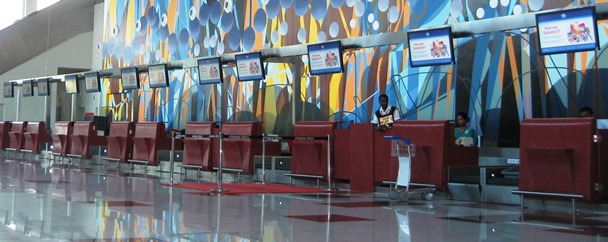[Empty counters of the Mattala Rajapaksa Air Port]
The Government is considering an unsolicited, single-bid proposal by a Chinese firm to set up a US$ 101 million oil pipeline between the Hambantota tank farm and the Mattala airport despite a study deeming the project to be economically unfeasible, reports the Sunday Times.
The study was coordinated by the Road Development Authority and commissioned from an independent party by the China Harbour Engineering Corporation (CHEC), which is to build the pipeline, authoritative sources said. At present, aviation fuel is taken from Kolonnawa to the Mattala Rajapaksa International Airport (MRIA) by tankers.
“With the current low demand at MRIA, it is cheaper to continue transporting fuel by tankers for the next four or five years,” a source said. “We also estimate that it would cost between US$30 and 40 million to construct the pipeline that the Chinese want to build for US$ 101 million.”
The feasibility study has compared the cost of road and rail transport with the pipeline and found that the pipeline will not be viable for years. The Bandaranaike International Airport, after 40 years in existence, requires 1.3 million litres of aviation fuel a day to cater to the aircraft that land there.
“According to the study, MRIA will require 10 million litres of aviation fuel a day for the pipeline to be viable,” the source said. “At present, SriLankan Airlines and Mihin Lanka use small quantities of fuel. The requirement for MRIA is an average of 1.8 million litres a month.”
Industry experts also said there would be an operational problem with the pipeline. It has recommended that aviation fuel must be stored in a pipeline only for a maximum of six months, the sources said. There are many reasons why this costly pipeline is not suitable at present but the Ceylon Petroleum Corporation wanted to proceed with negotiations, they said.
The CHEC submitted its proposal during the past two months. The sources said the RDA coordinated the feasibility study because the pipeline was to be built along the corridor between the proposed rail track and expressway linking the airport and the port.
